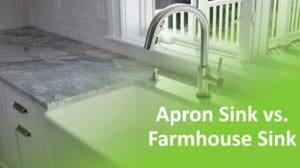With so many options to choose from, you might be scratching your head about where to start looking and exactly what to look for in a farmhouse sink. We’re here to help!
Our Top 6 Picks for the Best Farmhouse Sink Reviews
We’ve taken the time to research some of the best farmhouse sinks on the market, so you don’t have to. Instead, save money and time by reading about these superior products and get all the info you need to make a wise buying decision.
1. Kraus KWF410 Farmhouse Sink
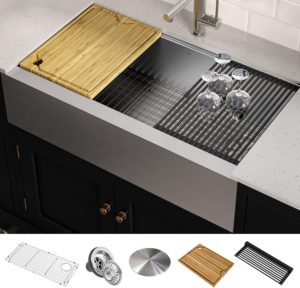
The Kraus farmhouse sink is solid, as it’s made of 16-gauge stainless steel. The finish is rust-resistant, and any scratches that may accumulate won’t be as visible as they would on a shiny exterior.
The Kraus features a flat front apron design and has a built-in workstation that saves space and allows you to multitask like a pro. This 36-inch model offers a variety of high-quality home chef accessories, like a solid bamboo cutting board that slips onto the integrated ledge to form a smooth surface between the countertop and board. Bamboo is also highly durable so that it won’t warp from water.
As one of the best farmhouse sinks on the market, the Kraus is also designed to hold large pots and pans and gives you plenty of space to soak and wash your dishes and kitchen tools. And when you’re ready to dry them, roll out the dish drying rack onto the ledge. When everything’s dry, simply roll up the rack and store.
Another added feature is the extra thick pads underneath the sink, which help to absorb sound. There’s also an undercoat that reduces noise and vibrations.
You’ll notice that the drain is slightly sloped to help water and debris move into the drainage area.
This is an excellent farmhouse sink with an industrial feel that gives you plenty of space to prepare food, soak tools, and wash and dry dishes. The only thing to keep in mind is that the sink is 10 inches deep and requires a fair amount of room to install, so ensure there’s adequate space on your counters before purchasing.
2. BOCCHI Apron Front Sink
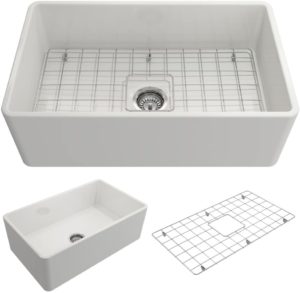
Fireclay is one of the most durable materials you’ll find in today’s kitchens. Heated in kilns with temperatures reaching 2000 degrees Fahrenheit, fireclay is designed to withstand maximum heat and resistant to even the hottest pots and pans.
Additionally, the material is easier to clean than standard ceramic, thanks to its smooth, glazed texture. Simply wipe down the surface using a microfiber cloth, and easily remove grime, germs, water spots, and fingerprints. The glaze is also non-porous, stain-resistant, and won’t easily crack, chip, or dent.
The only complaint some people have with the Bocchi is that the drainage slope is not as pronounced, which makes removing food debris slightly more of a hassle.
3. Swiss Madison SM-KS243 Farmhouse Sink
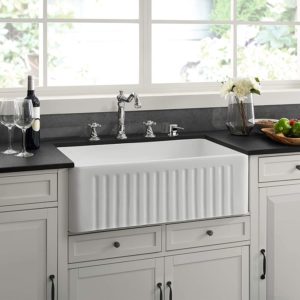
Although it’s simply designed and doesn’t come with all the bells and whistles some other farmhouse sinks do, the Swiss Madison offers you exactly what you need to get the job done.
With a 30×18 inch basin, this elegant, ceramic farmhouse sink gives you ample room to clean up. Plus, the Swiss Madison farmhouse sink is unique in that it’s reversible. One side displays vertical stripes, while the other side features horizontal ridges.
The sink is constructed of stain-resistant ceramic and comes in a glossy white finish.
You won’t find a wire rack or any extras included with the Swiss Madison, but there’s beauty in its simplicity. The high-quality material, large basin, modern aesthetic, and price point make this farmhouse sink one worth considering.
4. Kraus KHF203 Double Bowl Sink
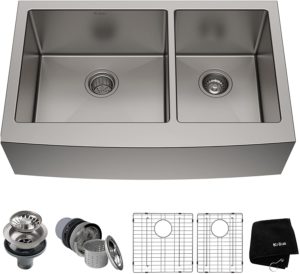
Featuring a 10-inch deep basin and two-sink design, the Kraus farmhouse sink provides plenty of area for soaking and washing dishes. Plus, the ample working space means you won’t have to worry about the sink always being full of dishes.
The Kraus double-bowl farmhouse sink is made from 16-gauge heavy-duty steel that’s rust-resistant and does not readily corrode or dent. There’s also undercoating to help protect cabinets from condensation buildup.
Underneath the sink, you’ll find extra-thick pads covering 80 percent of the base, which work to absorb noise made from dishwashing and disposal.
One of the unique features of the Kraus double-bowl sink is the rounded corners. Whereas sharp corners are usually more challenging to clean, round corners make cleanup simple, and they help reduce water trapping. With a round-shaped sink, you also get more workspace inside the basin.
This Kraus edition sink comes grooved with a slight slope to help with drainage. There are two grids and drain strainer baskets to work against clogging.
Although this sink is rust-resistant, you still need to wipe it down daily to prevent rust spots. Some reviewers found that if they left water sitting in the sink for too long, small spots formed that were hard to remove.
5. Ruvati Stainless Steel Sink
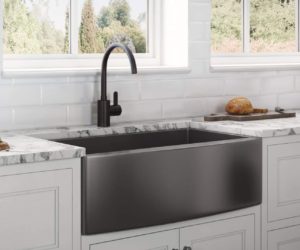
The sink is constructed from highly-durable 16-gauge, T-304 grade stainless steel and is finished in a matte black coating. As with most sinks, the stainless steel is rust-resistant, but the Ruvati takes it up a notch by completing it with a nano-PVD technique that makes the surface even stronger against wear and tear.
The matte texture not only adds a stylish touch to your kitchen, but works against fingerprint and stain accumulation.
Be sure to take measurements of your kitchen countertops before purchasing the Ruvati, as some reviewers found the sink on the larger side. Still, even at 33 inches wide, people love the look of this sink. If you’re partial to compliments, this may be the sink for you!
6. Houzer Fireclay Sink
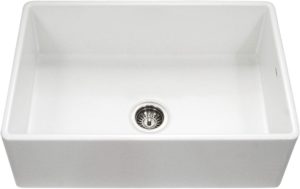
Rounded corners make cleaning up much easier, and the non-porous surface provides a hygienic, stain-free, glossy surface to work on.
Most people love this sink for its artisan style. The chic, white finish and apron front make it the centerpiece of a kitchen.
Some users’ only problem is that the sink bottom is entirely flat, making drainage a bit more challenging.
Different Materials for Farmhouse Sinks
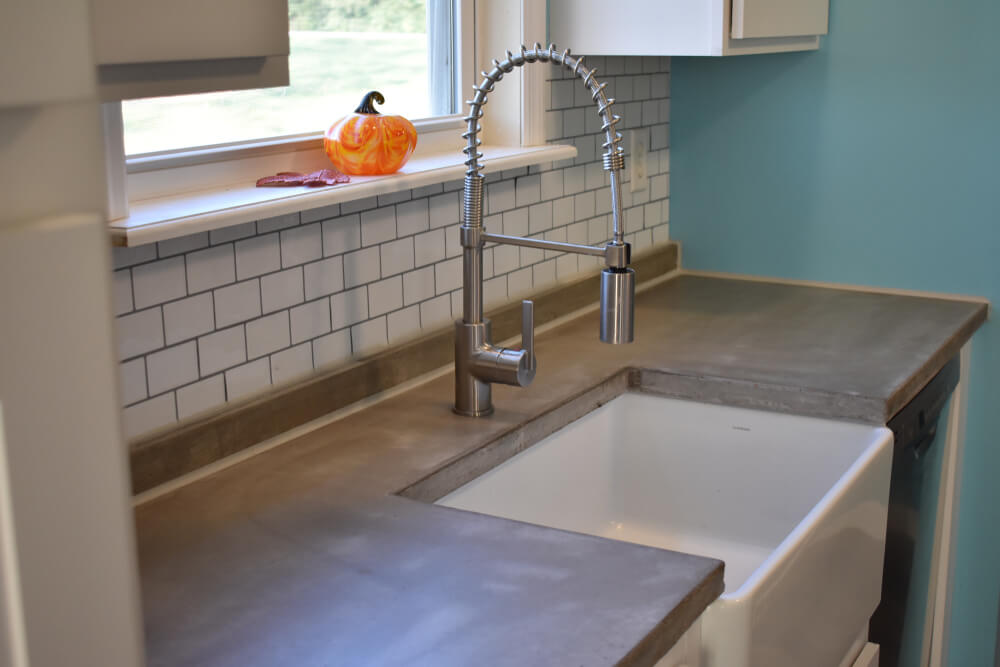
When searching for a quality kitchen sink, you may come across plenty of stainless steel farmhouse sink reviews, but these fixtures come in all sorts of materials. What kind of material you choose will determine factors like the sink’s durability and how easy it is to clean. So what are the different materials for farmhouse sinks?
Let’s take a closer look at the most popular materials you’ll find for the best farmhouse sinks.
Stainless Steel
At a glance:
- Has a smooth, matte finish
- Modern apron-front designs create a contemporary look
- Resistant to cracking, chipping, and staining
- Low maintenance and easy to clean
We couldn’t make a list of common sink materials and not include stainless steel. It is one of the most popular because of its low cost, durability, and ease to clean and maintain.
Stainless steel is typically classified by the gauge (thickness level). The higher the gauge, the lighter the steel. Residential sinks usually have a gauge between 18 and 22, and most people tend to think a thicker gauge equals higher quality. However, a Consumer Reports study showed that thicker steel was only slightly more resistant to scratches and dents and a bit less noisy.
Copper
At a glance:
- Comes in smooth and hammered finishes
- More detailed and intricate designs available for apron-front models
- Copper naturally kills germs and bacteria
- Needs waxing and cleaning with a copper cleaner
Copper farmhouse sinks are unique in that they are typically handcrafted, adding a touch of warmth and charm to the heart of the home.
New copper is shiny and gold-like, but the copper’s natural finish (the patina) will turn the material into a deep rosy-brown color over time. For example, compare a brand new penny to an old one and notice the difference in coloring. This process is natural, and although there are ways to slow it down, it can’t be stopped entirely.
One of copper’s most significant benefits is that it can kill 99.9 percent of bacteria. Copper creates a toxic environment for germs, viruses, and all kinds of bacteria. Since cooking spaces and sinks can turn into breeding grounds for germs, having a farmhouse sink made out of copper is a huge asset.
Cast Iron
At a glance:
- Made of solid cast iron and treated with hard porcelain enamel
- Has a smooth, glossy finish
- Resistant to cracking, chipping, and breaking
- Low maintenance and easy to clean
Cast iron is, you guessed it, made by casting iron. The bare iron receives a strong porcelain enamel finish to give the sink a smooth but tough surface. This enamel is actually hard melted glass that gets fused to the iron, creating a wall of resistance to stains, scratches, cracks, and rust.
The sink’s glassy surface is easy to maintain and keep clean, and the porcelain decreases damage due to light and fading.
Although the enameling on a cast iron sink is designed to withstand wear and tear, it’s not completely impervious to damage. Should the enamel chip and the bare iron get exposed, it will rust.
Another thing to consider with cast iron is that it’s heavier than most other materials, weighing in at 100 pounds or more. This makes installation more of a challenge, especially if a contractor needs to build additional supports underneath the counter to hold the sink in place.
Fireclay
At a glance:
- Has a smooth, glossy finish
- Often designed with flat fronts, but may have grooves or vertical lines to create texture
- Resistant to rust, fading, and discoloration
- Easy to clean and maintain
Fireclay sinks are constructed from ceramic clay that gets molded and dried at high temperatures for up to 40 hours. After the clay dries, a porcelain enamel finish is applied to the sink before it’s put into a kiln to bake at 2000 degrees Fahrenheit (or more) for 20 hours. This process increases the strength of both the clay and the enamel, making the material nearly indestructible.
Fireclay farmhouse sinks look similar to cast-iron sinks, but are typically more resistant to scratching and staining. The material is also heavy and usually needs extra support built-in underneath the sink.
Stone
At a glance:
- Comes in a wide variety of colors and patterns
- Natural stone ensures that no two sinks are alike
- Apron-front designs range from the traditional flat surface to more intricate carved motifs
- Stain-resistant
- Easy to clean
Stone farmhouse sinks made from marble, granite, soapstone, or quartz offer some of the most attractive natural designs. Color variations and pigmentation create unique patterns, which means every stone sink is a work of art.
Stone is a robust and durable material, but it’s also porous, so a stone sink must be treated with sealing to prevent surface damage. Once treated, the surface is non-porous, so food particles and other debris can’t get stuck inside any holes in the material. This makes the sink more resistant to staining and is much easier to clean.
Other lesser-known farmhouse sink materials you can find include black slate, bronze, brass, concrete, wooden, and bamboo.
Pre-Purchase Considerations
Aside from the different farmhouse sink materials, there are other factors to keep in mind before purchasing one of these fixtures for your kitchen.
Number of Bowls
Single and double-bowl farmhouse sinks are the most popular and the ones you’ll commonly find on the market. You’ll need to think about your countertop space and kitchen size before deciding how many basins you want to be included in your farmhouse sink.
It would help if you also considered whether having one bowl will make cleanup more difficult. If you’re used to having two bowls in your kitchen sink – one for soaking and one for rinsing – then you may want to invest in a double-bowl farmhouse sink.
Bowl Size
Farmhouse sinks are typically large fixtures and often have deep basins. Single-bowl sizes range from 24-42 inches, and the depth of the bowl can measure anywhere between 6 and 15 inches deep.
Installation
Because of their weight and size, farmhouse sinks generally need extra supports installed beneath the counters. This means you may need to alter your cabinetry in order to accommodate the sink. Farmhouse sinks are not attached to countertops, so custom cabinetry or custom support for existing cabinetry is recommended.
It’s also important to remember that most farmhouse sinks do not come with faucet holes or mounting decks. You need to make sure you have enough space for the faucet and the sink, as you’ll need to place the faucet behind the sink, either directly on the countertop or on a wall-mount above the sink.
Drainage
It may not seem like an important factor, but where the drain is placed, and its size can alter the sink’s efficiency. The drain hole should be at least 3.5 inches. If the drain is located in the middle of the sink, you may end up blocking the hole while washing dishes. On the other hand, an off-center drain makes washing up a bit easier and gives you more space beneath the counter.
Drainboard
Farmhouse sinks with built-in drainboards offer a convenient way to drain and dry dishes when hand-washing. The drainboard can also act as a food prep area.
Finishes
The best farmhouse sinks are made from high-quality materials that are rust-proof and stain-resistant. Always look at the specifications to see what kind of coating the sink was treated with, as the type will determine its appearance and how long the fixture lasts.
Noise Insulation
If you hate the loud clang of pots, pans, and silverware against the sink, purchasing one with noise-proof features is your best bet. These models often use extra thick padding on the underside to prevent impact noise. Some may even incorporate thick layers of exterior coating to decrease noise levels.
Apron Design
The front of the farmhouse sink, known as the apron, is what remains exposed after installation and can be as classic or decorative as you wish. Many farmhouse sinks come with flat, smooth apron fronts, but you can also find sinks with overhanging lips, fluted or grooved fronts, and hammered textures.
Cost
Farmhouse sinks range from hundreds to thousands of dollars depending on the type of material used and the design. Of course, spending thousands of dollars on a sink doesn’t necessarily mean you’re getting a quality product.
The best thing to do is study farmhouse sink reviews like this to get an idea of what’s available and what to look for when shopping for your own. Most of the sinks listed in this review provide everything you could want or need in a farmhouse style fixture and at an affordable price.
Frequently Asked Questions
If you’ve read this far then, you know all about the best farmhouse sinks, what they’re made of, and what to consider before purchasing one. But it’s totally understandable if you still have questions. There is a lot to learn about these kitchen beauties, and we’re here to help.
Here are some commonly asked questions about farmhouse sinks.
Also called a farmer’s sink or an apron sink, the design is usually wide with a deep basin and nothing protruding from the corners. The defining feature is the finished front (the apron) that’s displayed after installation. Farmhouse sinks can hold many more dishes, which makes washing up a smoother and cleaner process. People love these sinks for their size, efficiency, and attractive style.
If you don’t already have cabinets installed or you’re planning on picking out new cabinets, then you can purchase them based on whatever size sink you choose. However, if you currently have cabinets installed or already picked out, the sink should measure three inches shorter than the cabinet it will be placed in. You also need to keep in mind the sink’s depth size, as this will determine how much underneath counter space you’ll have leftover.
Once you invest in a farmhouse sink, you’ll want to take care of it to increase its longevity. The sink’s material will determine what cleaning products you should use and how often the sink needs cleaning. A general guide for cleaning farmhouse sinks:
1. Use a soft brush, cloth, warm water, and soap.
2. Avoid harsh chemicals and stiff bristles, as these may damage the sink’s surface.
3. Remove debris and food particles, then rinse the sink with warm water. Combine the soap and water and gently scrub the bottom and corners of the sink.
4. Rinse with clean water and check for any remaining muck.
5. Continue cleaning until you get the desired results.
Use a soft cloth when cleaning fireclay and porcelain, and avoid using abrasive chemicals on these materials. For stainless steel, you can use a scrub brush to remove grime and stains. Also, remove water on the basin to prevent water spot stains.
A sink grid protects the sink from scratches and other surface damage. It can also absorb the impact from heavy pots and pans and prevents dishes from blocking the drain. A sink grid isn’t necessary, but it is handy for these reasons.
All the different types of farmhouse sink materials have their advantages and drawbacks, but when looking at durability and cost, stainless steel offers the best product for the money. The material is durable, long-lasting, easy to maintain, and is resistant to cracks, stains, and chipping.
Yes and no. Custom cabinets are recommended due to ease of installation, but you can alter your existing cabinets to support a farmhouse sink. This process may include reworking the face, cutting down cabinet doors, and building reinforcements to support the sink’s hefty weight.
Final Thoughts
A farmhouse sink provides durability, functionality, and style to the heart of the home. The right farmhouse sink can transform how your kitchen looks and how you approach washing the dishes. The large size and depth of these sinks make the whole process much more manageable. Plus, some farmhouse sinks even provide workstation space.
If you’ve read our best farmhouse sink guide, then you’re on the right path to finding a cost-effective and functional kitchen sink that you can enjoy for years.
Overall, we think the Kraus Farmhouse Sink is one of the best on the market due to its high-quality features, space-saving workstation, and sink accessories.
For budget buyers, the Swiss Madison Farmhouse Sink provides everything you need in a simple, but beautifully-designed fixture. You may not get all the bells and whistles that some of the other sinks offer, but you will get a quality sink that’s as practical as it is pretty.
Lastly, the Ruvati Stainless Steel Sink is the perfect alternative to the classic farmhouse sink style. The matte gunmetal black finish pops against lighter-colored cabinetry and provides a surface that’s not easily damaged.
See Also:





